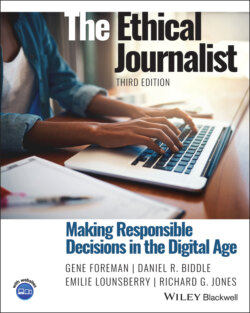Читать книгу The Ethical Journalist - Gene Foreman - Страница 68
The Evidence of Public Hostility
ОглавлениеIt is an irony that, even as the news media have matured and have strived to fulfill an obligation of social responsibility, the public has grown hostile. The hostility is painfully evident to anyone answering the telephone, or reviewing incoming email at news outlets, or perusing the reader comments appended to online news stories, or sampling the dialogue on social media.
There also is empirical proof. With occasional upticks, the public’s declining trust has been documented in surveys since the 1980s.
A Gallup Poll (Fig. 5.1) showed in 2019 that Americans were continuing to be mistrustful of the mass media. Asked if they thought the mass media would report “fully, accurately and fairly,” only 41% expressed “a great deal” or “a fair amount” of confidence. When Gallup first measured trust in the mass media in 1972, 68% of Americans reported that level of trust. By 1997, trust was 53%.8
Gallup pointed to widely divergent opinions held by Republicans and Democrats “in the current highly polarized climate” of the Donald Trump administration. Among Democrats, 69% trusted the mass media “a great deal” or “a fair amount.” Among Republicans, only 15% rated the mass media that highly. Gallup found that a majority of Republicans trusted only one source of national news: Fox News.9
In 2020, two other surveys – one by the Pew Research Center and the other a collaborative effort by Gallup and the Knight Foundation – confirmed the public’s skepticism about the news media and revealed dark suspicions about journalists’ conduct. Key findings from those surveys are shown in Fig. 5.2.
The Pew survey showed that only 48% of Americans had “a great deal” or “a fair amount” of confidence that journalists “act in the best interest of the public.” 10
Even more troubling, from an ethics standpoint, was Pew’s finding that 44% think reporting mistakes happen because of a desire to mislead the public.11
The Gallup-Knight Foundation survey also found that significant numbers of Americans think reporting is sometimes deliberately wrong. The Gallup-Knight report concluded, “Americans perceive inaccurate news to be intentional – either because the
reporter is misrepresenting the facts (52%) or making them up entirely (28%).”12
To anyone who has worked in a newsroom of a mainstream news outlet, those findings are astonishing. According to the two surveys, roughly half of the people think journalists intentionally mislead the audience, and about a quarter of them think journalists fabricate the news. Students reading this textbook should be aware that a reporter who committed either offense would likely be fired.
Both surveys found that Republicans mistrust journalists’ conduct far more than Democrats.
Gallup conducts a periodic poll on perceived honesty of various occupations ( Fig. 5.3), and its 2019 poll confirmed that the public remains unimpressed with journalists’ ethics.
Gallup’s respondents ranked journalists in the middle of the pack – 11th out of 22 occupations rated. Twenty-eight percent of those surveyed thought journalists had “very high” or “high” ethics standards. In Gallup’s survey in 1981, 32% of respondents thought journalists had “high” or “very high” ethical standards. In the 27 surveys since then, all but one of the ratings of journalists have been lower than the 1981 score.13
